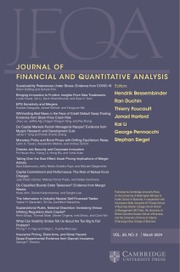Article contents
IPOs, Human Capital, and Labor Reallocation
Published online by Cambridge University Press: 18 February 2025
Abstract
How does access to public equity markets affect the human capital of IPO filing firms? While IPO filing firms have high average wages and limited industrial diversification, a successful IPO increases departures of high-wage employees to startups and triggers industrial diversification through employment growth in non-core industries. Surprisingly, IPOs do not significantly affect the earnings growth of pre-IPO workers. Instead, post-IPO hires receive larger earnings increases upon joining. Overall, going public has a significant effect on a firm’s workforce and labor reallocation across firms.
Information
- Type
- Research Article
- Information
- Copyright
- © The Author(s), 2025. Published by Cambridge University Press on behalf of the Michael G. Foster School of Business, University of Washington
Footnotes
We thank Mara Faccio (the editor), Meghana Ayyagari, Shai Bernstein, Sen Chai, Thomas J. Chemmanur, Mike Ewens, Laura Lindsey, Elena Loutskina, Debarshi Nandy, Merih Sevilir, Mindy Zhang, seminar participants at Columbia University, HBS-Entrepreneurship, North Carolina State, the University of Minnesota, the University of Naples Federico II, the SEC, the University of Virginia and conference participants at the AFA, Darden and Cambridge Judge Entrepreneurship and Innovation Research Conference, Cavalcade, Changing Role of Stock Markets in Capital Formation-NYU, Midwest Finance Association, NBER Entrepreneurship Working Group, SMLR Fellowship Program Workshop, the Society of Labor Economists (SOLE) annual conference, Texas Finance Festival, and the Tuck Private Equity and Entrepreneurship Research Conference. We thank Belinda Chen for outstanding research assistance. We thank Shirley Liu, Danielle Sandler, and Emily Wisniewski for their diligent assistance with the data and clearance requests. The views and conclusions are those of the authors and do not necessarily indicate concurrence by the Federal Reserve Board, other members of its staff, or other members of the Federal Reserve System. The research in this paper was conducted while the authors were Special Sworn researchers of the U.S. Census Bureau at the Triangle and Baruch Census Research Data Center. Any views expressed are those of the authors and not those of the U.S. Census Bureau. The Census Bureau has reviewed this data product to ensure appropriate access, use, and disclosure avoidance protection of the confidential source data used to produce this product. This research was performed at a Federal Statistical Research Data Center under FSRDC Project Number 881 (CBDRB-FY24-0105).
References
- 2
- Cited by

